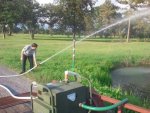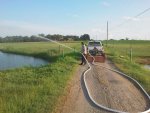Do any of you have fire hoses, and fire hose connections on your pool pumps? I ask because I bought the fittings and a lightly used 100 ft 1.5 inch fire hose and reel that came out of a closed factory off ebay (total investment about $150) with the intention of hooking them up to my pool pump just in case a year or so ago, and never did get around to it until this weekend when I changed out my pool pump. One big factor in my decision to go ahead and hook it up while I was working on pool plumbing is a nearby house burned down Friday afternoon, I don't know the details yet, but it took the fire department about 20 minutes to arrive, and by then there was no saving the house. I don't know that I will ever need it, but it is nice to have the option of delivering over a gallon a second of water, in my brief test I can say this certainly beats a garden hose.
Ike
Ike



